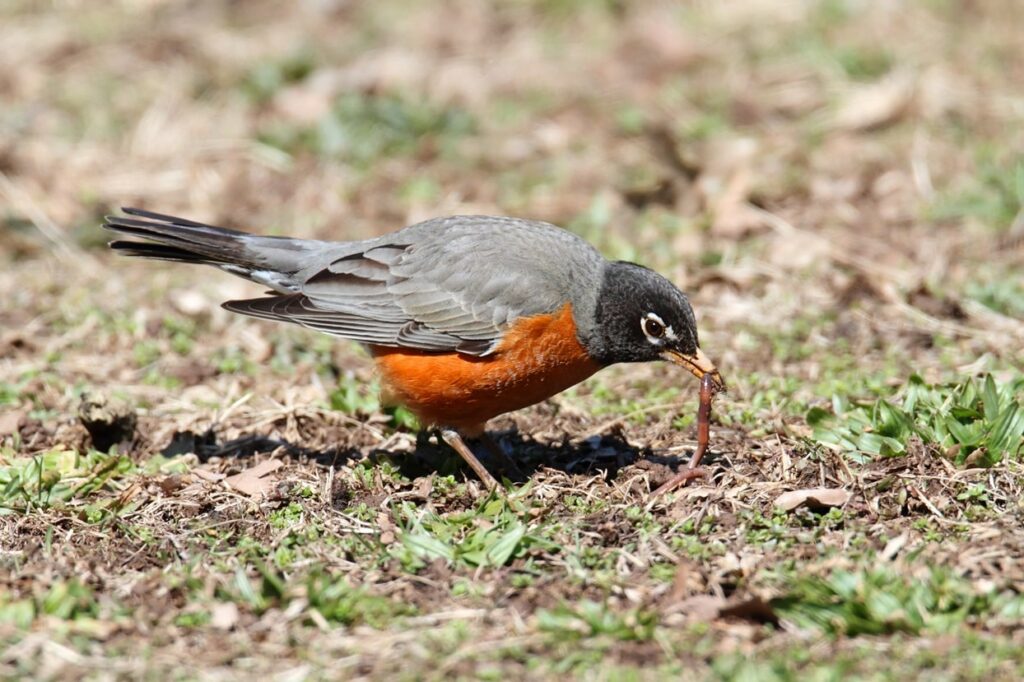While not all birds will feast on a worm meal, some actively seek worms under the soil surface to complete their daily eating routines. However, since worms hide well under the soil, how do birds find them?
Birds usually rely on their keen eyesight to find earthworms, although they may use their hearing and sense of touch. Moreover, some have specialized bills that facilitate the process of spotting and catching worms.
If you want to learn more, keep on reading! You won’t believe how resourceful birds can be!
How Do Birds Find Worms?
The way a bird finds worms depends on the species. Furthermore, it may also depend on the circumstances – sometimes the eyesight is enough, and other times they rely on their hearing, too.

Can Birds See Worms?
Most birds usually have keen eyesight. If a worm pokes out of the soil just a bit, the bird will spot it right away! Moreover, birds can spot the slightest movements on the soil surface, which is immediately associated with worms roaming underneath.
Can Birds Hear or Sense Worms?
Hearing can be of use sometimes if worms move under the soil. It is also believed that some species may use their tactile receptors to detect movement and vibrations beneath their feet.
However, there’s no scientific confirmation that any bird relies on its touch or hearing sense alone to hunt for worms. Most likely, it’s just an aid to their vision.
Birds With Specialized Bills
Some birds have sharp, specialized bills that allow them to pull the earthworms from the soil. Take American woodcocks, for example. They have extraordinary bills adapted to probing for earthworms – more precisely, they’re long and prehensile.
It inserts its bill into the soil, and thanks to the unique bill arrangement, the American woodcock can open and close its tip bill under the soil, thus being able to catch earthworms and other invertebrates.
Birds With Unique Hunting Techniques
Besides this, some species, like the European robin, associate worm meals with human activities that imply soil digging or gardening. For this reason, European robins are often called the “gardener’s friends” and will often gather on one’s lawn right after it’s been mown.
Other birds, like chickens, turkeys, geese, or even pheasants usually follow the same pattern – they’ll likely gather around to look for worms in areas where the soil has been recently disturbed and the invertebrates are closer to the surface. Chickens have also been observed digging holes in the ground to look for worms!
The American robin has a unique hunting technique to catch worms. It’s called “running and stopping,” as it’s often spotted running across lawns and stopping to pick up earthworms when it sees or senses one. Another species exhibiting a similar behavior is the common blackbird.
Another essential thing to note is that many birds will most likely look for worms at dawn or dusk, as that’s when most worms are active. If you’ve heard the proverb The early bird catches the worm, now you know what the story behind it is!
Why Do Birds Eat Worms?
First, birds eat worms because that’s a deeply-rooted behavior (and craving) they’ve acquired over thousands of years.
Secondly, worms are beneficial for a bird’s body. They’re high in protein, which sustains their health – no wonder many adult birds look for worms for their babies! Moreover, worms come with multiple vitamins and minerals, which are essential to healthy development.
What Birds Eat Worms?
While not all birds “focus” primarily on hunting worms, as they rely on other food sources as well, worms still represent a major source of protein in their diets.
Here are some bird species that feed on worms:
- American woodcock (Scolopax minor) – it feeds primarily on earthworms but occasionally takes snails, centipedes, spiders, ants, and seeds.
- European robin (Erithacus rubecula) – it feeds on worms, spiders, berries, insects, and seeds.
- American robin (Turdus migratorius) – it feeds on caterpillars, earthworms, grasshoppers, fruits, and berries.
- Common blackbird (Turdus merula) – it feeds on earthworms, berries, fruits, and insects.
- Three-banded plover (Charadrius tricollaris) – it feeds on worms, insects, and other invertebrates.
- White-fronted plover (Charadrius marginatus) – it feeds on grasshoppers, termites, small crustaceans, and worms.
- Malayan night heron (Gorsachius melanolophus) – it feeds on frogs and earthworms; occasionally preys on arachnids, snails, insects, and crabs.
- Snowy plover (Charadrius nivosus) – it feeds on crustaceans, beetles, and worms.
- Little owl (Athene noctua) – it eats earthworms and insects, as well as small amphibians, birds, and reptiles.
- Killdeer (Charadrius vociferus) – it feeds on worms, millipedes, spiders, seeds, and snails.
